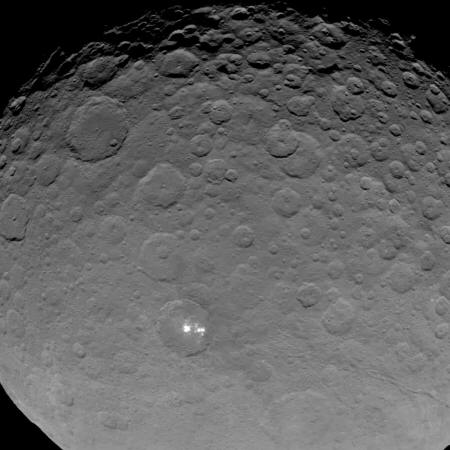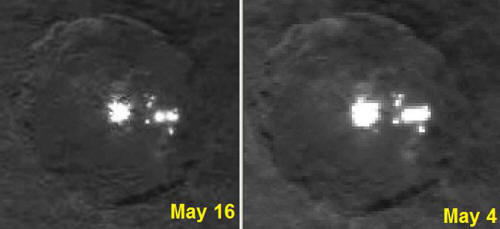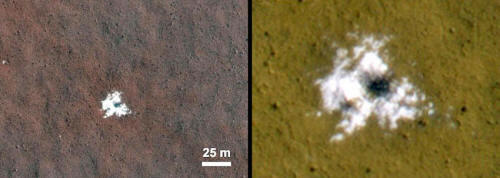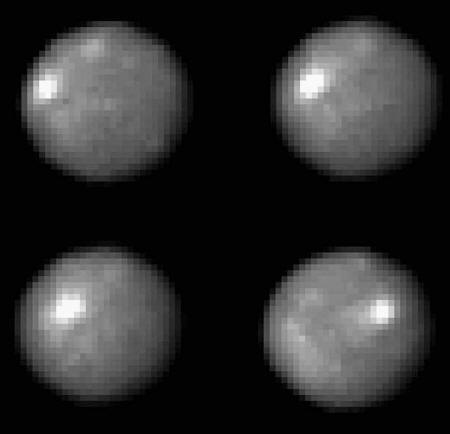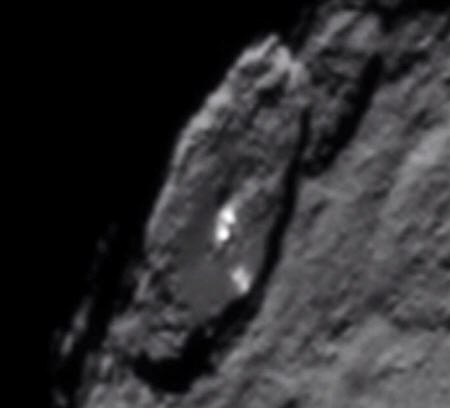|
|
|
from
UniverseToday Website
in the 57-mile-wide crater on the dwarf planet Ceres. Scientists with the Dawn mission believe they’re highly reflective material, likely ice.
Credit:
NASA/JPL-Caltech/UCLA/MPS/DLR/IDA
The latest views of Ceres' enigmatic white spots are sharper and clearer, but it's obvious that space probe Dawn will have to descend much lower before we'll see crucial details hidden in this overexposed splatter of white dots.
Still, there are hints of interesting things going on here.
Comparison of the most recent photos of the white spots taken Dawn's current 4,500 miles vs. 8,400 miles on May 4. Credit: NASA/JPL-Caltech/UCLA/MPS/DLR/IDA
The latest photo is part of a sequence of images shot for navigation purposes on May 16, when the spacecraft orbited 4,500 miles (7,200 km) over the dwarf planet.
Of special interest are a series of troughs or cracks in Ceres crust that appear on either side of the crater housing the spots.
While the exact nature of the spots continues to baffle scientists, Christopher Russell, principal investigator for the Dawn mission, has narrowed the possibilities:
The bright material in both photos was excavated from below the surface and deposited nearby by a 2008 impact that dug a crater about 26 feet (8 meters) in diameter. The extent of the bright patch was large enough for the Compact Reconnaissance Imaging Spectrometer for Mars, an instrument on NASA's Mars Reconnaissance Orbiter, to obtain information confirming it as water ice. Credit: NASA/JPL-Caltech/University of Arizona
We've seen ice exposed by meteorite/asteroid impact before on Mars where recent impacts have exposed fresh ice below the surface long hidden by dust. In most cases the ice gradually sublimates away or covered by dust over time.
But if Ceres' white spots are ice, then we can reasonably assume they must be relatively new features otherwise they would have vaporized or sublimated into space like the Martian variety.
NASA's Hubble Space Telescope took these images of the asteroid 1 Ceres over a 2-hour and 20-minute span, the time it takes the Texas-sized object to complete one quarter of a rotation. The observations were made in visible and in ultraviolet light. Hubble took the snapshots between December 2003 and January 2004. Credit: NASA, ESA, J. Parker, P. Thomas and L. McFadden
Much has been written - including here - that these spots are the same as those photographed in much lower resolution by the Hubble Space Telescope in 2004.
But according the Phil Plait, who writes the Bad Astronomy blog, that's false. He spoke to Joe Parker, who was part of the team that made the 2004 photos, and Parker says the Dawn spots and Hubble spots are not the same.
Could the spots have formed post-2004 or were they simply too small for Hubble to resolve them? That seems unlikely. The chances are slim we'd just happen to be there shortly after such a rare event occurred.
And what happened to Hubble's spot - did it sublimate away?
Dawn's still frames of Ceres by Tom Ruen. Watch as the spots continue to reflect light even at local sunset.
Watching the still images of Ceres during rotation, it's clear that sunlight still reflects from the spots when the crater fills with shadow at sunset and sunrise.
This implies they're elevated, and as far as I can tell from the sunrise photo (see below), the brightest spots appear to shine from along the the side of a hill or mountain.
Could we be seeing relatively fresh ice or salts after recent landslides related to impact or tectonic forces exposed them to view?
Single from from the video shows the white spots shortly after sunrise. The brightest appear to be located on a central mountain peak. It's unclear if the pair of spots below the bright pair are situated on a rise or the flat floor. Credit: NASA
Let's visit another place in the Solar System with an enigmatic white spot, or should I say, white arc. It's Wunda Crater on Uranus' crater-blasted moon Umbriel.
The 131-mile-wide crater, situated on the moon's equator, is named for Wunda, a dark spirit in Aboriginal mythology. But on its floor is a bright feature about 6 miles (10 km) wide.
We still don't know what that one is either!
The moon Umbriel, 727 miles in diameter, with Wunda Crater and its bright internal ring of unknown origin. The moon's equator is vertical in this photo. Credit: NASA
|


